Table of Contents
- Introduction
- Editor’s Choice
- Home Improvement Services Market Overview
- Top Home Service Projects
- Leading Hardware and Home Improvement Retailers – By Retail Sales
- Motivation Behind Home Improvement
- Planned Home-Related Activities Among Homeowners
- Average Home Renovation Budgets
- Return on Investment (ROI) from Home Renovation
- Top Funding Sources Among Home Renovators
- Length of Home Renovation Projects
- Home Remodeling Projects with the Highest Cost Recovered
- Remodeling Projects with the Lowest Cost Recovered
- Home Improvement Challenges
- Adoption of Smart Technology in Homes
Introduction
According to Home Improvement Statistics, The home improvement industry, a crucial part of construction, thrives due to urbanization, higher incomes, and changing lifestyles.
Renovations, remodeling, and upgrades by homeowners, contractors, and specialized providers shape this vibrant sector.
It includes various areas like interior and exterior renovations, energy-efficient updates, and smart home integration.
Influenced by demographic changes, housing markets, and technological progress, major retailers such as Home Depot and Lowe’s dominate alongside smaller suppliers.
Advancements like AR tools and smart home tech revolutionize project planning. Despite challenges like economic uncertainty and labor shortages, the industry holds promise, driven by urbanization, tech innovation, and sustainability, offering opportunities for stakeholders.
Editor’s Choice
- The global home improvement services market revenue reached USD 381.9 billion in 2023.
- By 2033, the market is anticipated to achieve USD 391.38 billion in offline revenue and USD 260.92 billion in online revenue.
- In 2020, among the most popular home service projects among households in the United States, interior painting was undertaken by 35% of households, indicating a strong preference for refreshing and updating home interiors.
- In 2022, among the leading hardware and home improvement retailers in the United States, Home Depot led the industry with retail sales amounting to USD 145.94 billion, highlighting its extensive market reach and consumer preference.
- According to the 2022 Remodeling Impact Report by the NAR, a substantial 83% of homeowners had already intended to renovate, irrespective of the pandemic.
- From 2020 to 2021, homeowners’ median spending increased by 20%, climbing from $15,000 to $18,000.
- Among homeowners who have finished their projects this year, primary obstacles encompassed locating suitable professionals (45%), acquiring products and materials (34%), and adhering to budgetary constraints (28%).

Home Improvement Services Market Overview
Global Home Improvement Services Market Size
- The global home improvement services market has demonstrated a steady growth trajectory at a CAGR of 5.50%, with revenue increasing from USD 381.9 billion in 2023 to USD 402.9 billion in 2024.
- This upward trend is projected to continue, reaching USD 425.1 billion in 2025 and USD 448.4 billion.
- Looking further ahead, the market is forecasted to achieve USD 586.1 billion in 2031, USD 618.3 billion in 2032, and USD 652.3 billion by 2033.
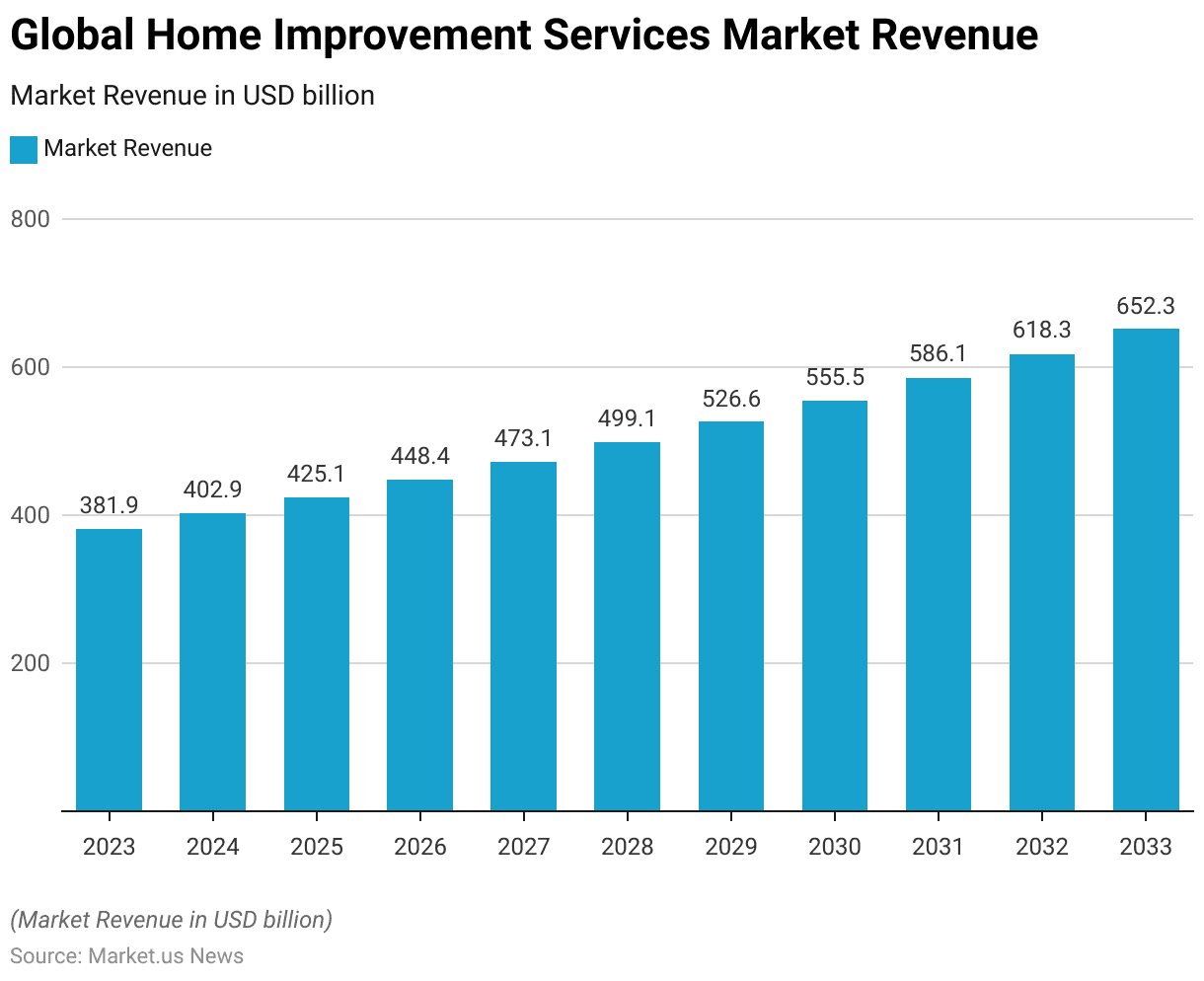
Global Home Improvement Services Market Size – By Deployment
- The global home improvement services market is experiencing significant growth, with the total market revenue projected to increase from USD 381.9 billion in 2023 to USD 652.3 billion by 2033.
- This growth is evident in both offline and online segments. In 2023, offline revenue accounted for USD 229.14 billion, while online revenue was USD 152.76 billion. By 2024, these figures are expected to rise to USD 241.74 billion offline and USD 161.16 billion online.
- By 2033, the market is anticipated to achieve USD 391.38 billion in offline revenue and USD 260.92 billion in online revenue.
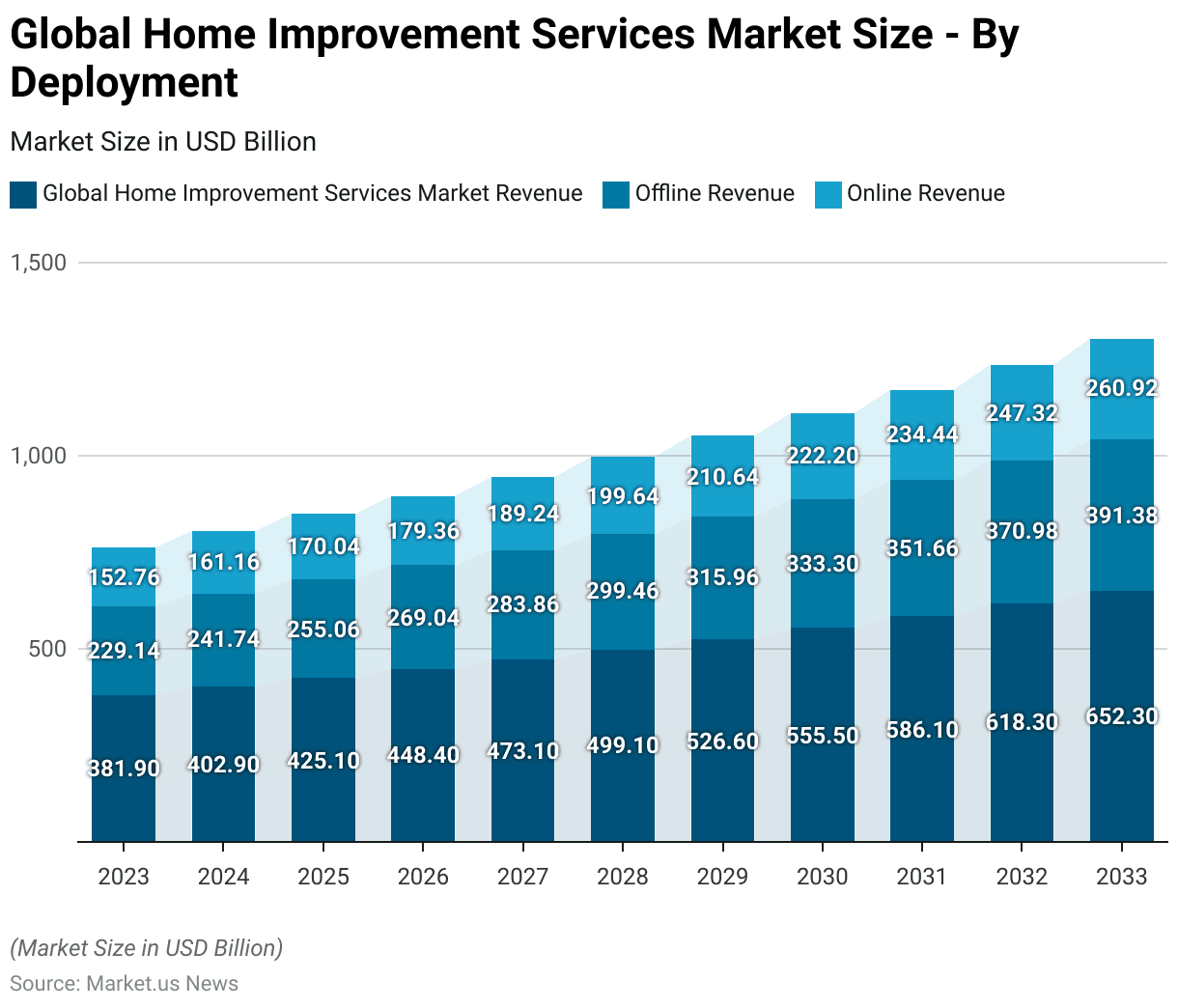
Top Home Service Projects
- In 2020, the most popular home service projects among households in the United States were diverse, reflecting a range of interior and exterior improvements.
- Leading the list, interior painting was undertaken by 35% of households, indicating a strong preference for refreshing and updating home interiors. Bathroom remodels followed closely, with 31% of households opting for this project, highlighting the importance of modernizing and enhancing bathroom spaces.
- New flooring installations were chosen by 26% of households, emphasizing the desire for upgraded and stylish flooring options. Landscaping projects were completed by 24% of households, showing significant interest in improving outdoor aesthetics and functionality.
- Kitchen remodels, a critical area for home value and enjoyment, were undertaken by 23% of households.
- Exterior painting projects were carried out by 19% of households, aligning with efforts to enhance curb appeal. Similarly, 19% of households invested in new smart home devices, reflecting a growing trend towards home automation and advanced technology integration.
- New roofing projects were completed by 16% of households, addressing essential home maintenance and protection. New fencing installations also accounted for 16% of household projects, contributing to improved privacy and security.
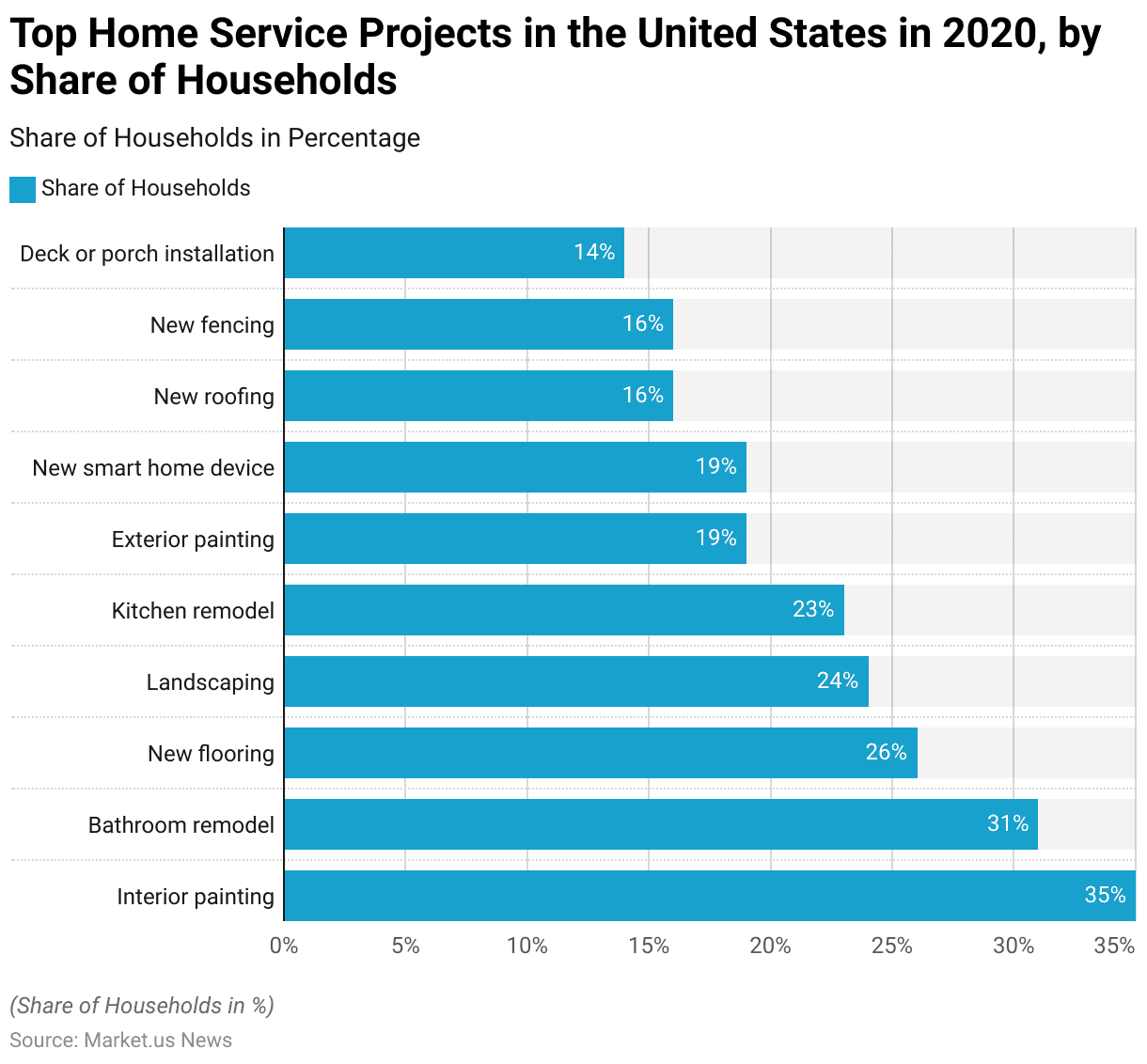
Leading Hardware and Home Improvement Retailers – By Retail Sales
- In 2022, the leading hardware and home improvement retailers in the United States demonstrated substantial market dominance through impressive retail sales figures.
- The Home Depot led the industry with retail sales amounting to USD 145.94 billion, highlighting its extensive market reach and consumer preference.
- Lowe’s Companies followed as the second-largest retailer, generating USD 89.28 billion in sales, reflecting its strong presence in the home improvement sector.
- Ace Hardware secured the third position with retail sales of USD 26.38 billion, showcasing its significant footprint in the market.
- Menards also maintained a prominent position, achieving USD 13.38 billion in retail sales.
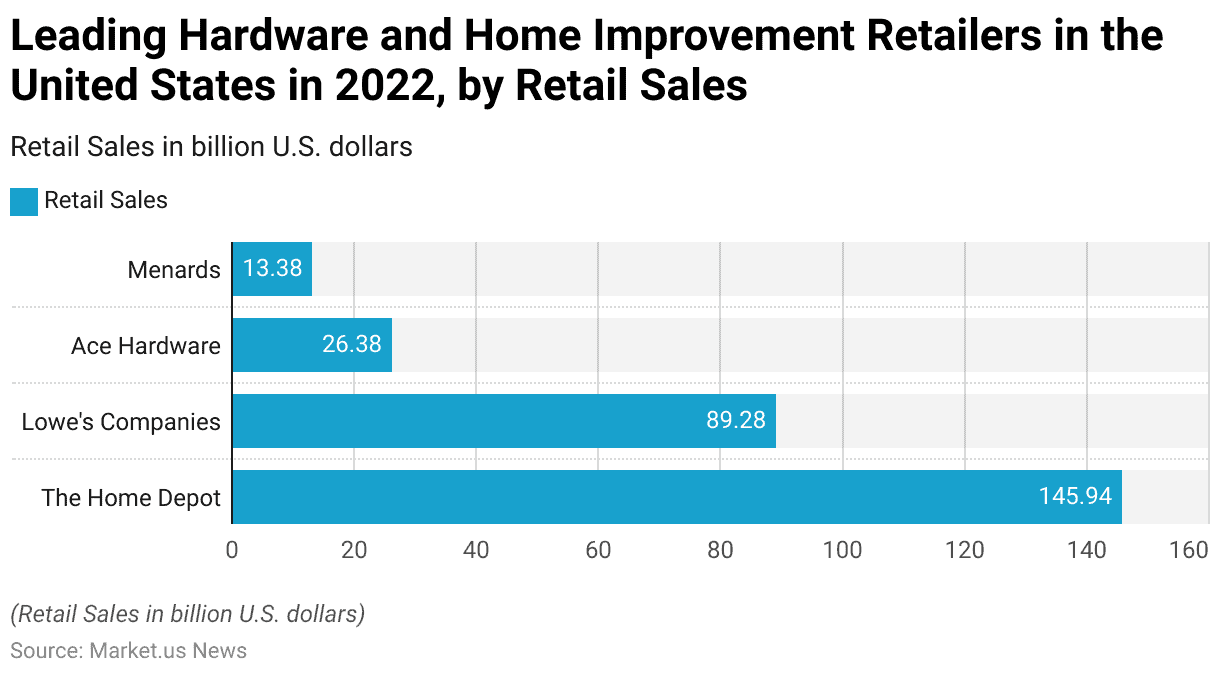
Motivation Behind Home Improvement
- The global situation itself didn’t solely drive the surge in home renovations during the pandemic.
- According to the 2022 Remodeling Impact Report by the NAR, a substantial 83% of homeowners had already intended to renovate, irrespective of the pandemic.
- Their motivations varied, with 30% aiming to upgrade worn-out surfaces, finishes, and materials, 20% seeking to add features and enhance livability, and 16% simply desiring change. The gratification derived from these home improvements significantly contributed to homeowners’ overall contentment with their living spaces.
- The NAR’s data revealed that 84% of homeowners expressed a desire to spend more time in their upgraded homes, while 69% reported heightened satisfaction with their residences.
- Moreover, 39% found fulfillment in witnessing the completion of their home improvement endeavors.
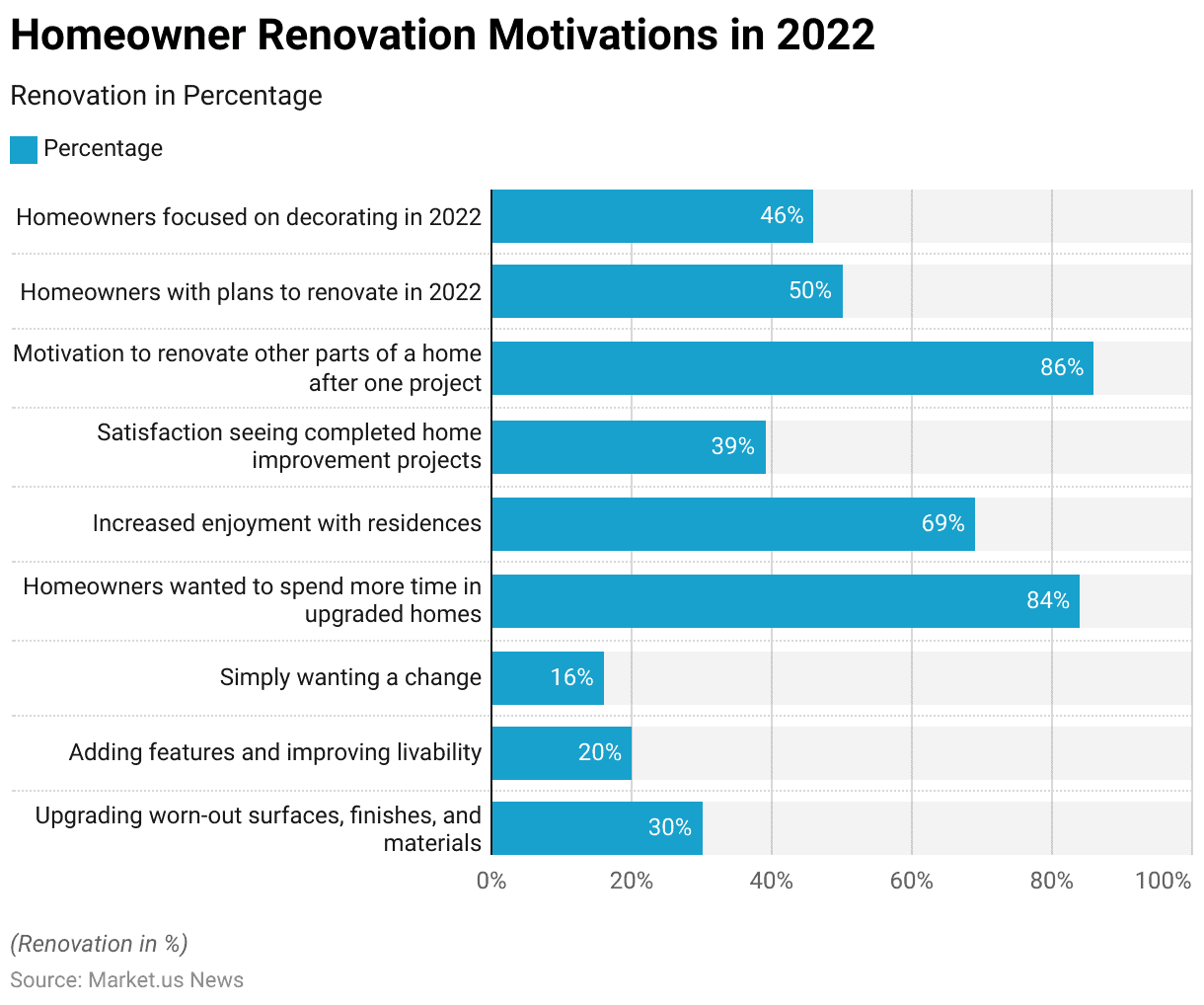
Planned Home-Related Activities Among Homeowners
- In 2022, homeowners engaged in a variety of home-related activities, reflecting their ongoing commitment to enhancing and maintaining their living spaces.
- Renovating was the most popular activity, with 55% of respondents planning to undertake renovation projects.
- Decorating followed, with 46% of homeowners intending to update their home interiors with new Homecare & Decor.
- Home repairs were also a significant focus, with 35% of respondents planning to address various maintenance issues.
- Additionally, 3% of homeowners expressed plans to build new homes, indicating a smaller yet notable interest in new home construction.
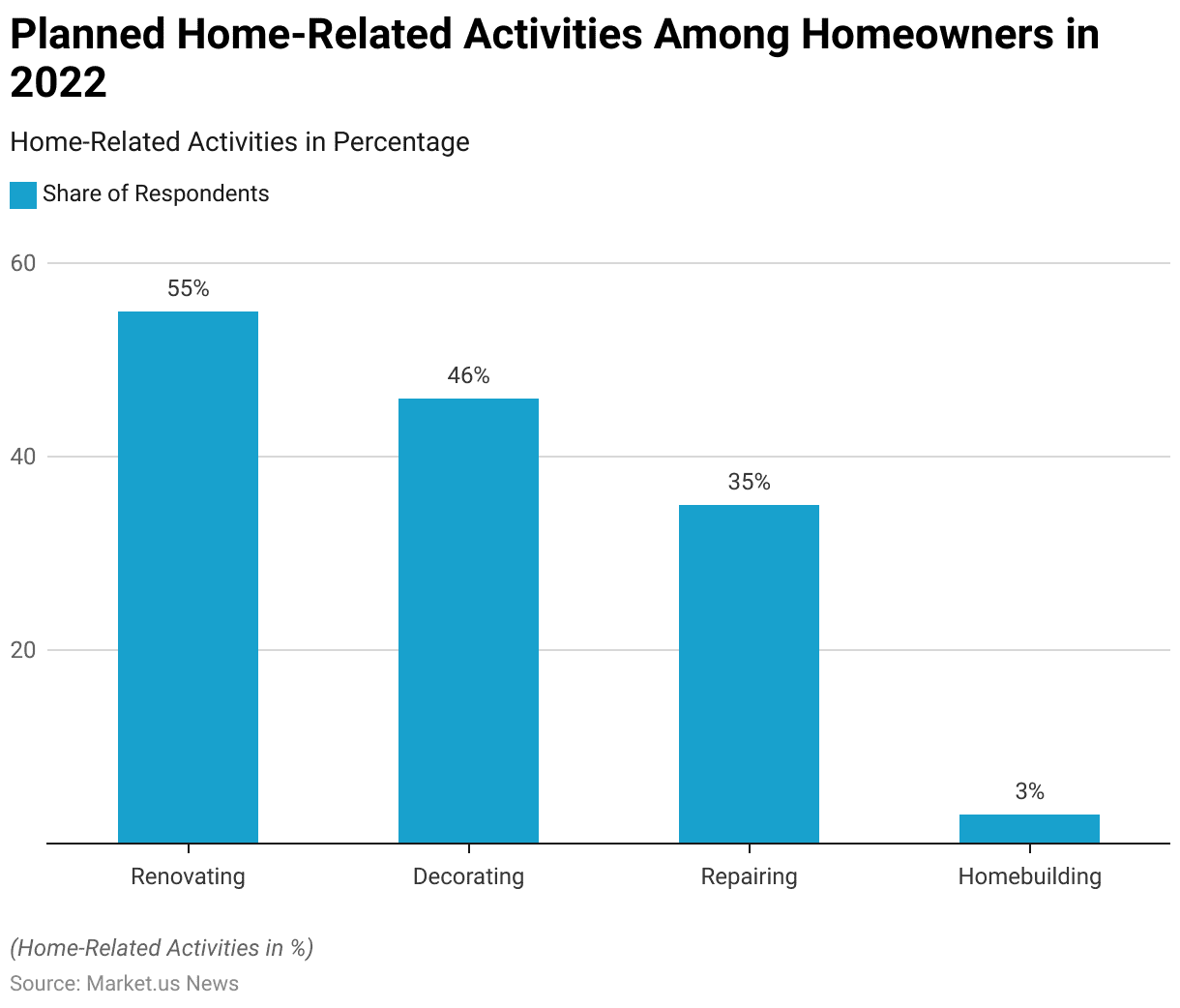
Average Home Renovation Budgets
- The 2022 U.S. Houzz and Home Study indicates a noticeable rise in home improvement budgets over recent years.
- From 2020 to 2021, homeowners’ median spending increased by 20%, climbing from $15,000 to $18,000. This marked the first uptick in planned renovation expenditures since 2018. However, projections from Houzz suggest a potential decrease in spending to $15,000 for 2022, although final figures have yet to be released.
- Moreover, spending patterns varied based on homeowners’ tenure. New home buyers, for instance, allocated up to $30,000 for renovations, twice the national median. Those who had owned their homes for one to five years spent an average of $19,000, while long-term homeowners residing in their homes for six or more years typically aligned with the national average of $15,000.
- In terms of project focus, interior room renovations took center stage in 2021. Kitchen renovations emerged as the most popular upgrade, commanding the highest budget allocation.
Return on Investment (ROI) from Home Renovation
Interior Remodeling ROI
- In the realm of interior remodeling projects, various upgrades have been shown to yield significant returns on investment (ROI) for homeowners.
- Refinishing hardwood flooring leads the list with an impressive ROI of 147%, making it the most lucrative interior improvement.
- Installing new wood flooring follows with an ROI of 118%, demonstrating the high value added by enhancing flooring.
- An insulation upgrade offers a solid return as well, with an ROI of 100%.
- Converting a basement into a living area provides an ROI of 86%, while closet renovations yield an ROI of 83%.
- Attic conversions to living areas and complete kitchen renovations both deliver an ROI of 75%, showcasing their potential to enhance home value significantly.
- Bathroom renovations offer a return of 71%, and kitchen upgrades have an ROI of 67%, further highlighting the benefits of updating essential home areas.
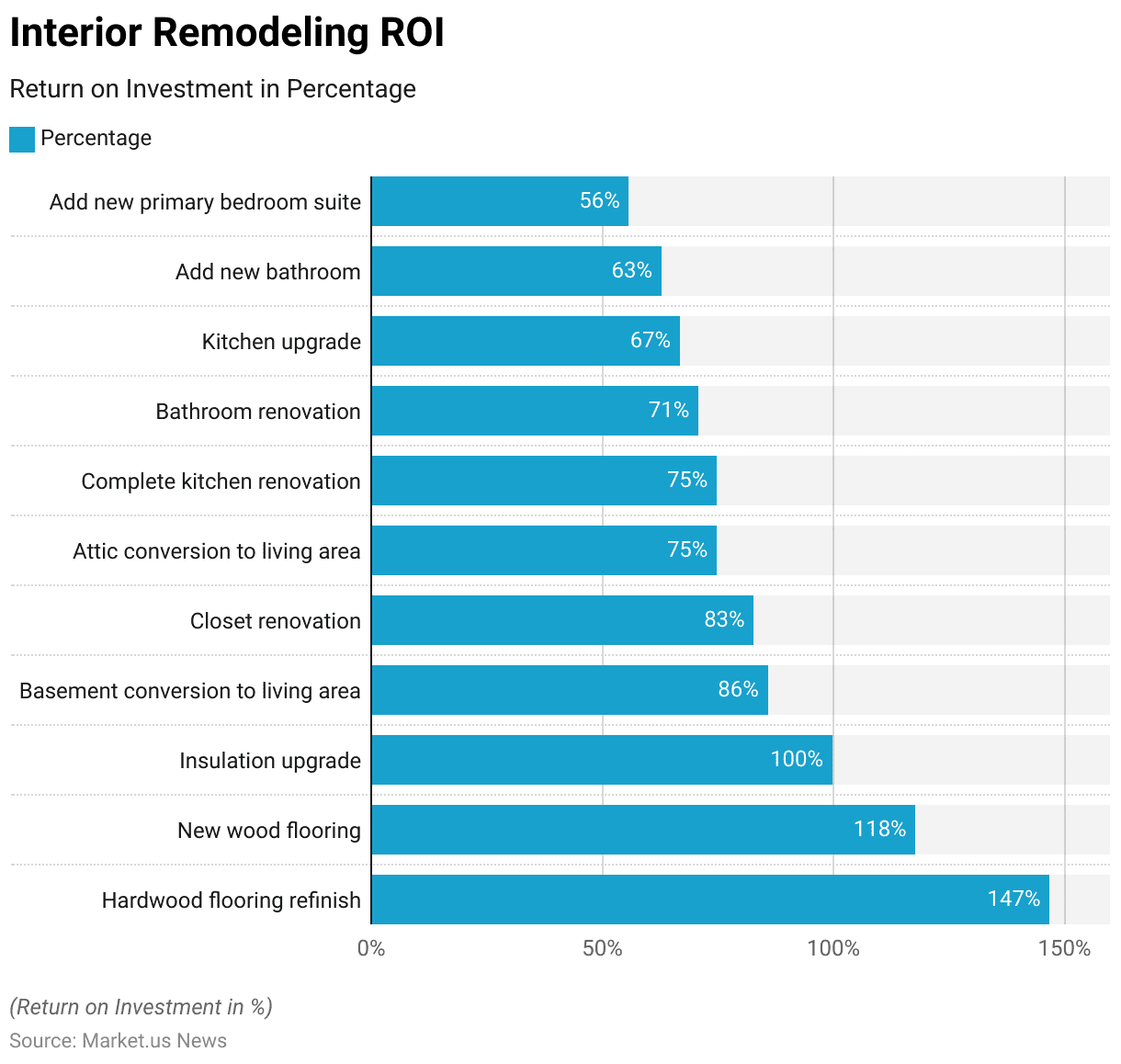
Exterior Remodeling Projects ROI
- Exterior remodeling projects can significantly enhance a home’s value, offering notable returns on investment (ROI).
- New roofing and garage door replacements top the list, each providing a complete ROI of 100%.
- Fiber cement siding installation offers an ROI of 86%, reflecting its durability and aesthetic appeal.
- Vinyl siding follows closely with an ROI of 82%, underscoring its cost-effectiveness and popularity.
- Upgrading to vinyl windows yields an ROI of 67%, while wood windows offer a return of 63%, indicating the added value of improved window installations.
- Replacing a steel front door also provides an ROI of 63%, contributing to enhanced curb appeal and security.
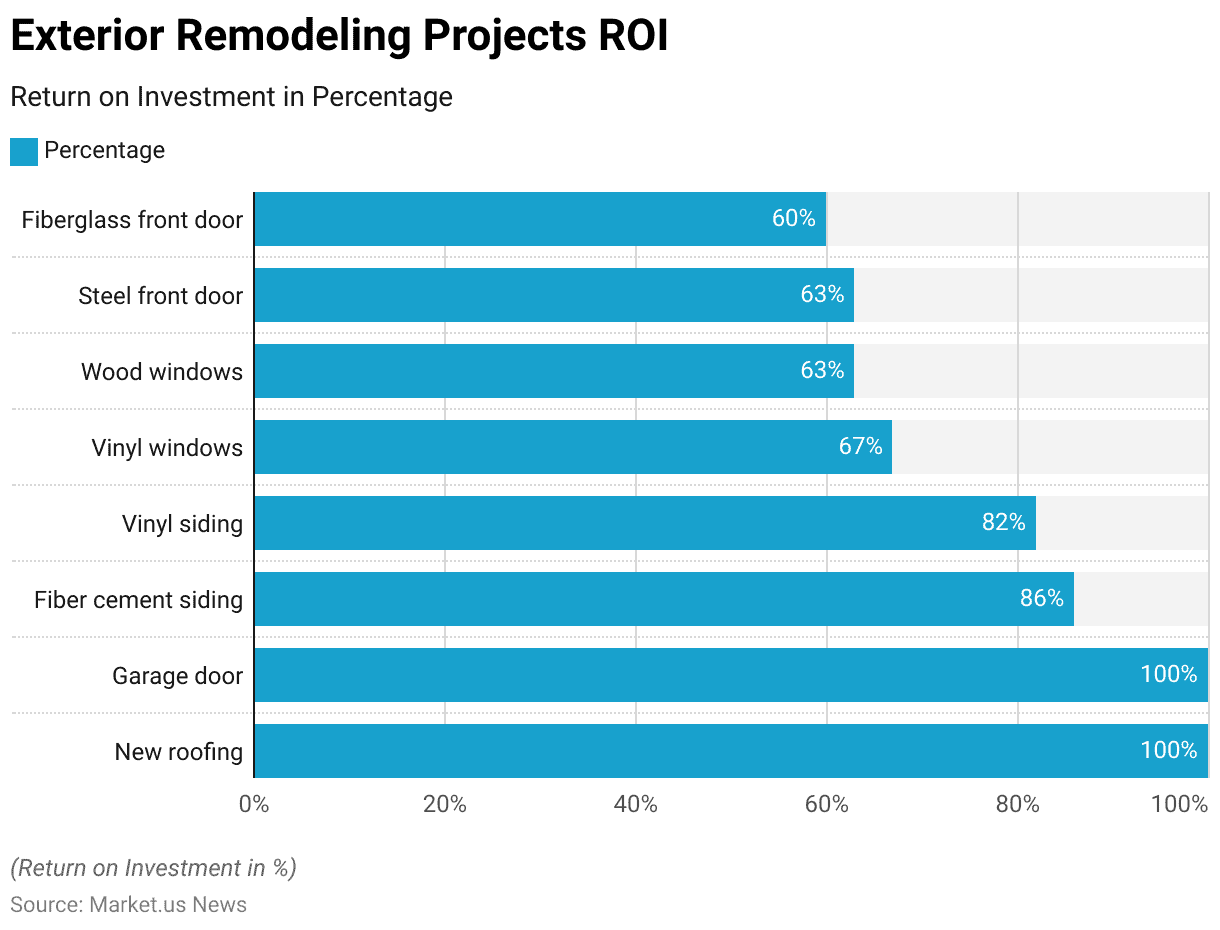
Top Funding Sources Among Home Renovators
- In 2021, homeowners who undertook renovation projects primarily funded these improvements through various sources.
- The most common funding source was cash from savings, utilized by 76% of respondents, indicating a strong preference for using personal funds.
- Credit cards were the second most popular choice, used by 35% of homeowners.
- Secured home loans accounted for 14% of the funding sources, showing a reliance on leveraging home equity.
- Tax refunds were used by 7% of respondents, while 10% funded their renovations with cash from previous home sales.
- Gifts or inheritances were utilized by 5% of homeowners, and insurance pay-outs accounted for 4%.
- Unsecured loans were a less common choice, used by 3% of respondents, and loans from retirement plans were the least used, at 2%.
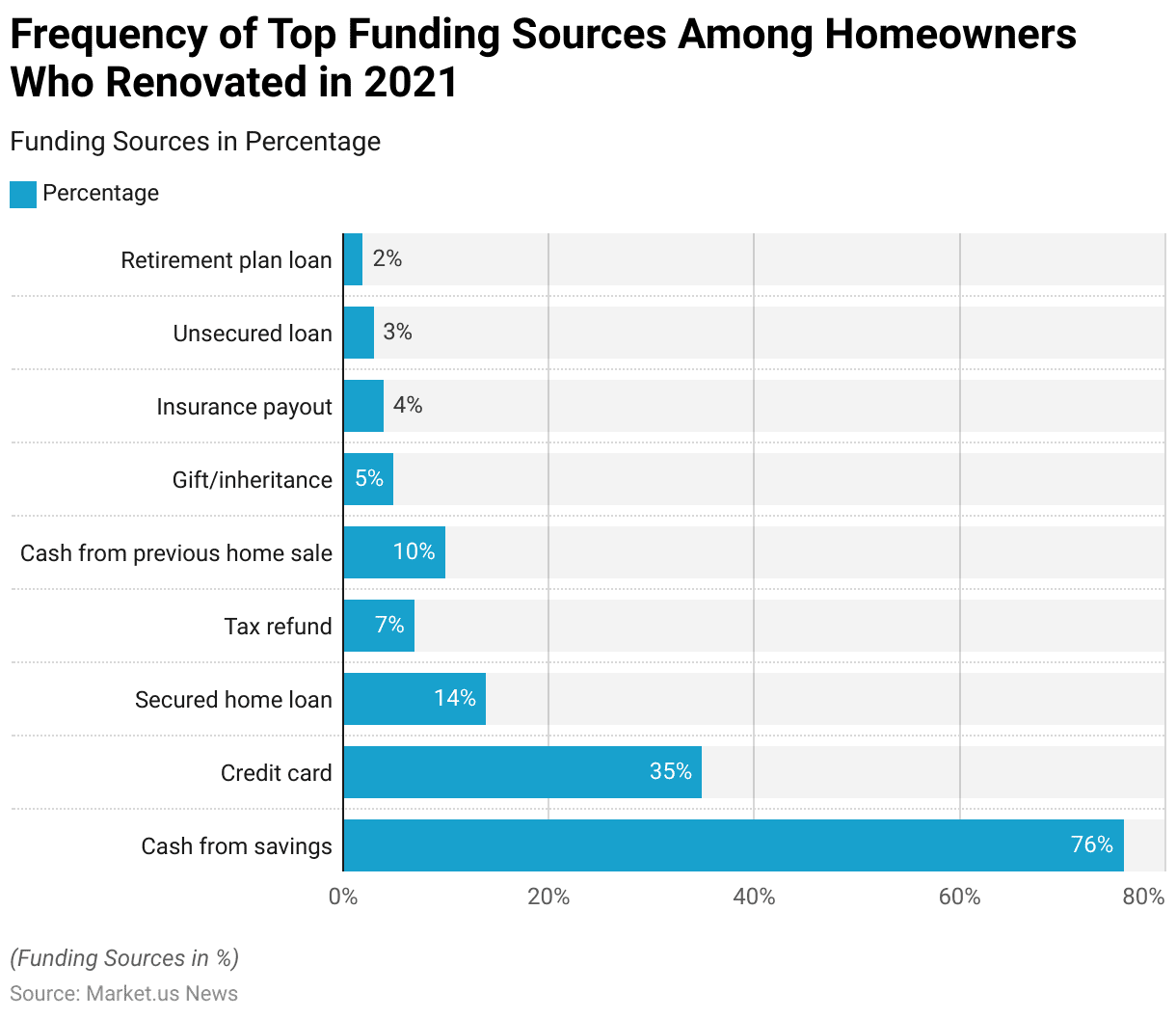
Length of Home Renovation Projects
- In 2021, the average length of home renovation projects among homeowners varied significantly depending on the type of project. Kitchen renovations required the longest time, with an average planning period of 8.6 months and a construction duration of 4.9 months.
- Primary bathroom projects followed, taking an average of 7.4 months to plan and 3.7 months to construct. Living room renovations had an average planning length of 7.2 months and a construction period of 3.5 months.
- Laundry room projects typically took 7.0 months to plan and 3.3 months to complete construction. Entry, foyer, and mudroom renovations shared the same planning period of 7.0 months but required 3.7 months for construction.
- Guest and other bathroom renovations averaged 6.8 months for planning and 3.5 months for construction, while primary bedroom projects needed 6.7 months for planning and 3.8 months for construction.
- Dining room renovations took 6.7 months to plan and 3.4 months to build. Garage renovations had an average planning length of 6.6 months and a construction duration of 3.5 months.
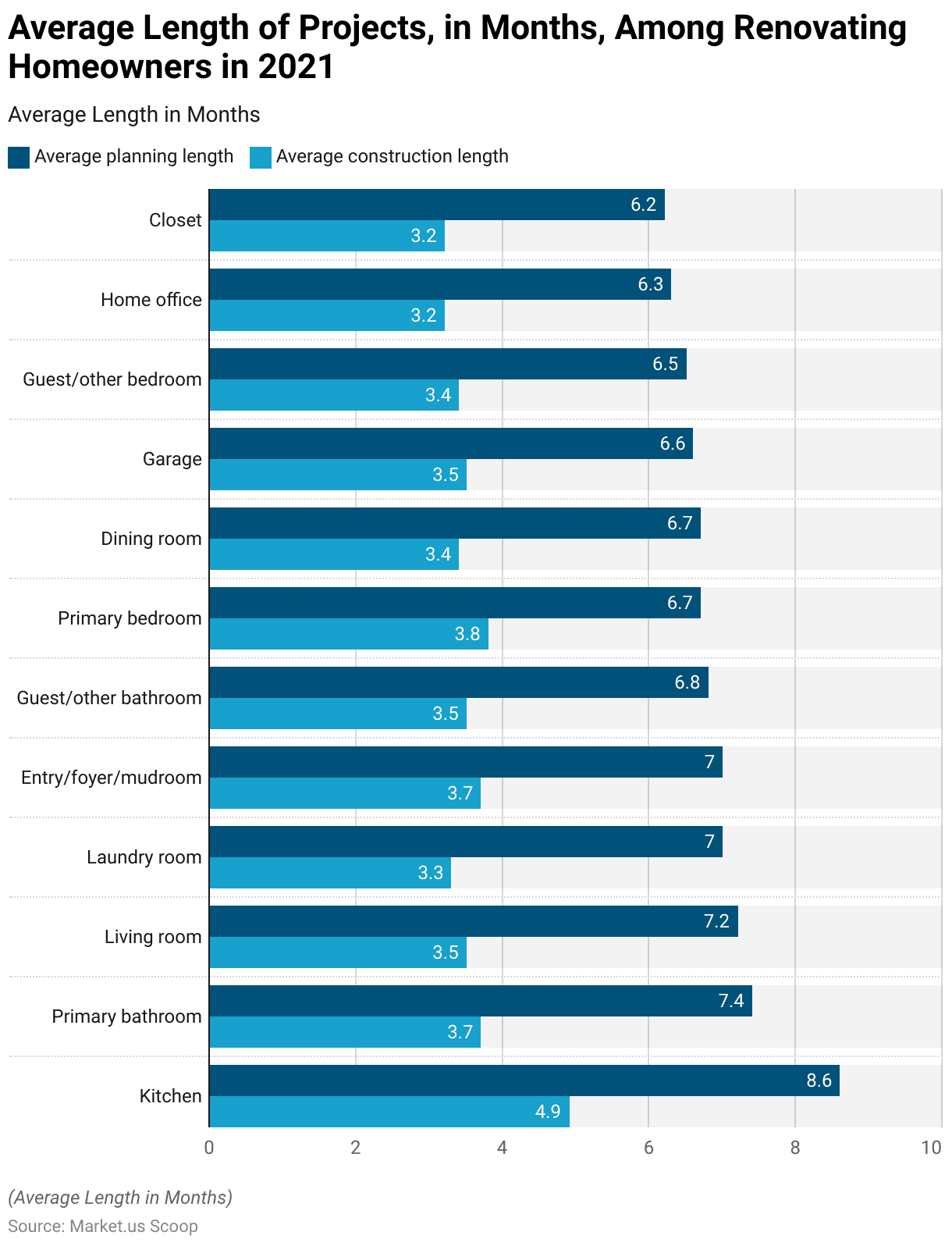
Home Remodeling Projects with the Highest Cost Recovered
- Home remodeling projects in 2022 varied significantly in terms of cost recovery, with some projects offering exceptionally high returns on investment.
- Garage door replacements topped the list, with homeowners recovering 100% of the costs.
- Wood window replacements followed closely, recouping 95.5% of their expenses.
- Adding a screened-in porch provided a substantial return, with 92.9% of the costs recovered.
- Fiber-cement siding replacements also proved valuable, with a 92.7% cost recovery rate.
- Vinyl siding replacements allowed homeowners to recover 91.0% of their investment, while both vinyl window replacements and in-ground pools had a cost recovery rate of 90.1%.
- Composite deck additions offered an 86.9% return, and concrete backyard patios provided an 86.4% cost recovery.
- Finally, wood deck additions yielded an 80.1% return on investment.
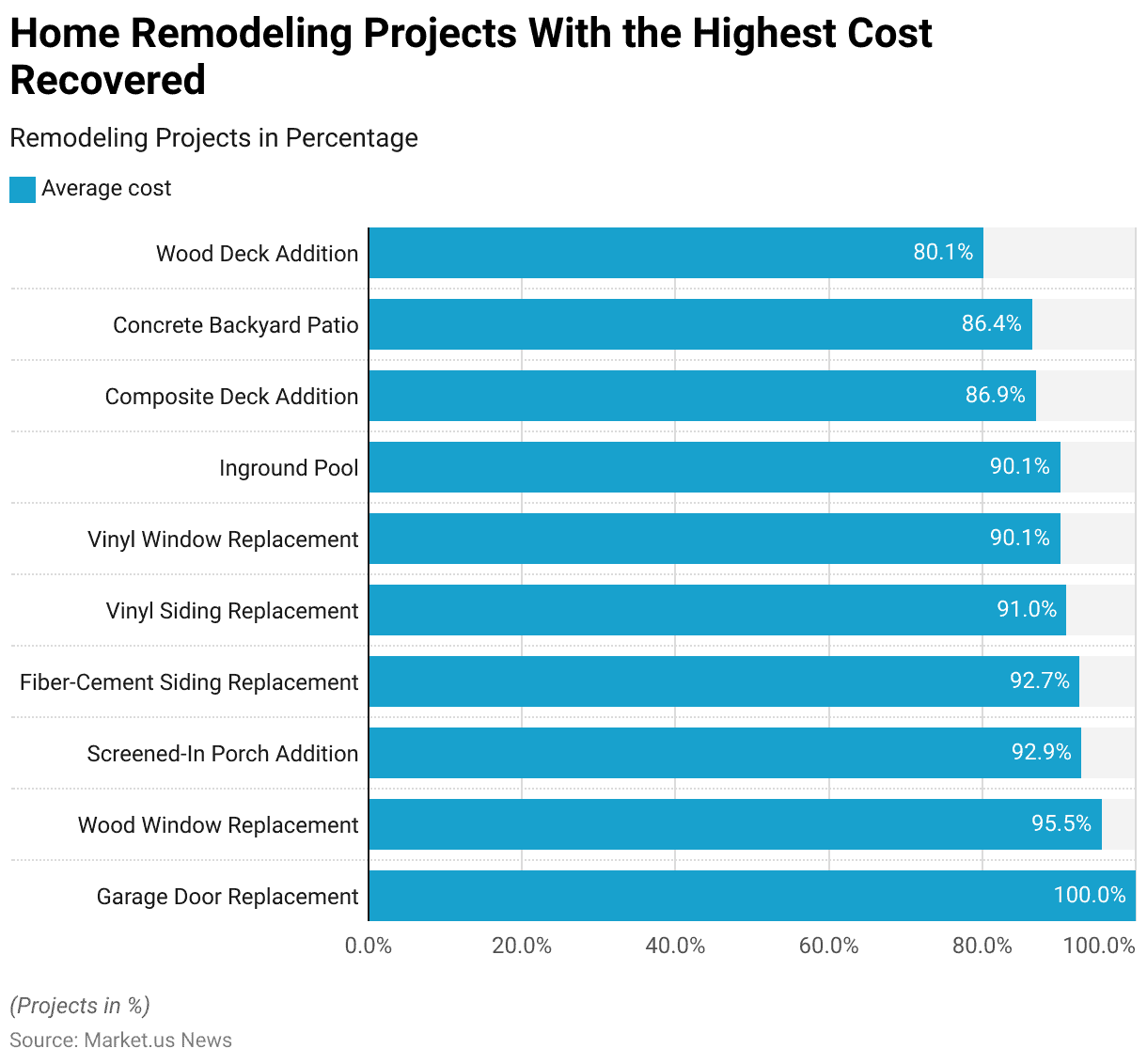
Remodeling Projects with the Lowest Cost Recovered
- In 2022, several home remodeling projects demonstrated lower cost recovery rates, making them less financially advantageous for homeowners.
- Finishing a basement yielded the lowest cost recovery, with only 22.7% of the expenses recouped.
- Upscale bathroom remodels provided a return of 48.8%, while midrange primary suite additions had a slightly higher cost recovery rate of 49.8%.
- Upscale primary suite additions and laminate kitchen countertops each recovered 50.0% of their costs.
- Upscale major kitchen remodels, midrange kitchen remodels, and second-floor garage additions all shared a cost recovery rate of 53.0%.
- Laminate flooring installations and minor kitchen remodels offered a slightly better return, with 56.0% and 56.8% of the costs recovered, respectively.
- Midrange bathroom additions also had a cost recovery rate of 56.8%.
- Manufactured stone veneer projects provided a higher return compared to the other projects in this category, with a cost recovery rate of 59.8%.
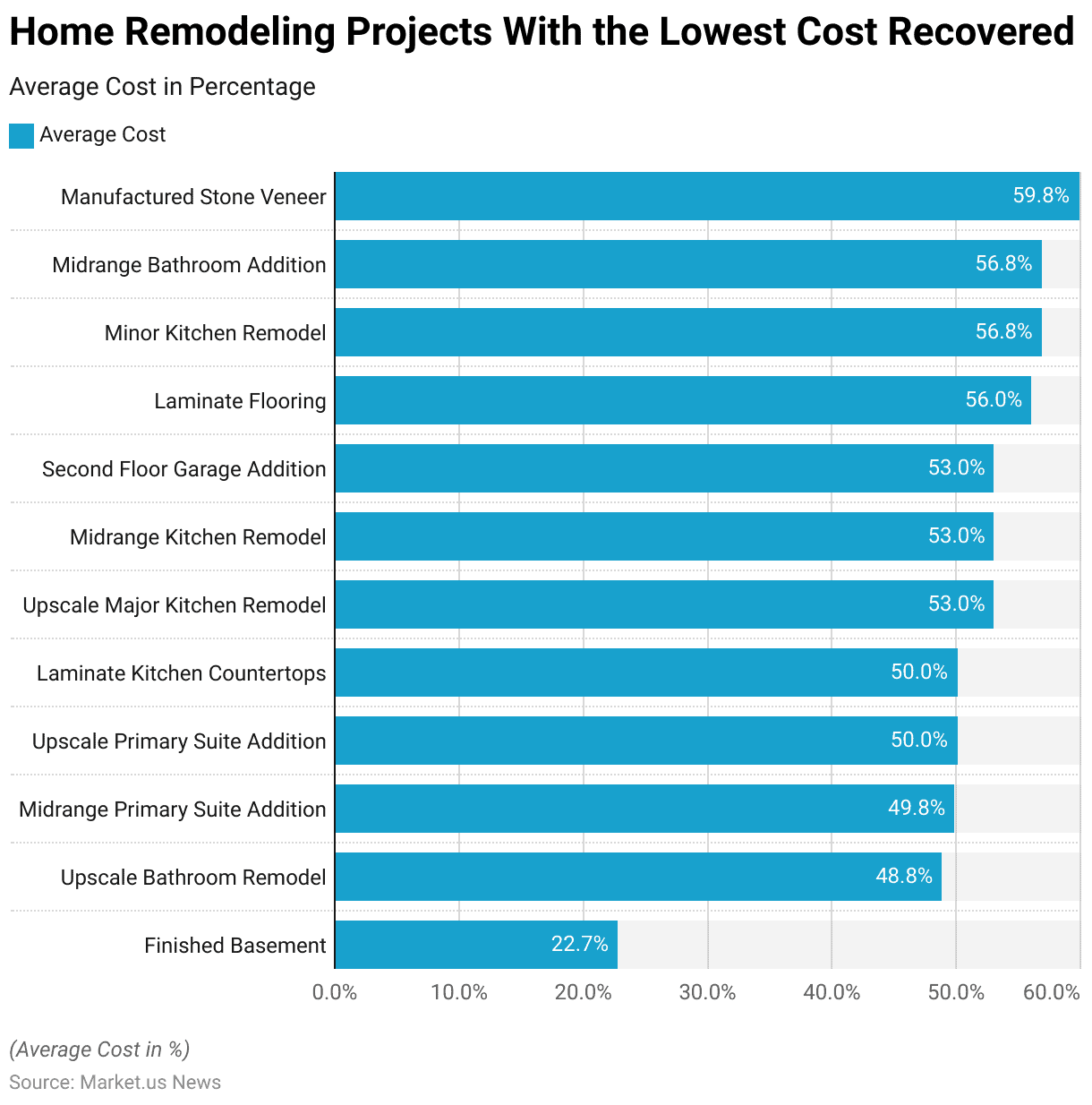
Home Improvement Challenges
Basic Challenges
- In response to economic challenges, 15% of homeowners have opted to delay a home improvement project scheduled for either this year or 2024, as per a survey conducted by Houzz in August 2023 among over 2,500 homeowners.
- Conversely, nearly one-third of surveyed homeowners (31%) have already finalized a home improvement project this year.
- A quarter (25%) are presently engaged in a project, while over a quarter (27%) intend to commence a project by the conclusion of 2024.
- On the other hand, less than 1% abandoned a planned project for this year, and none anticipate canceling a project slated for 2024.
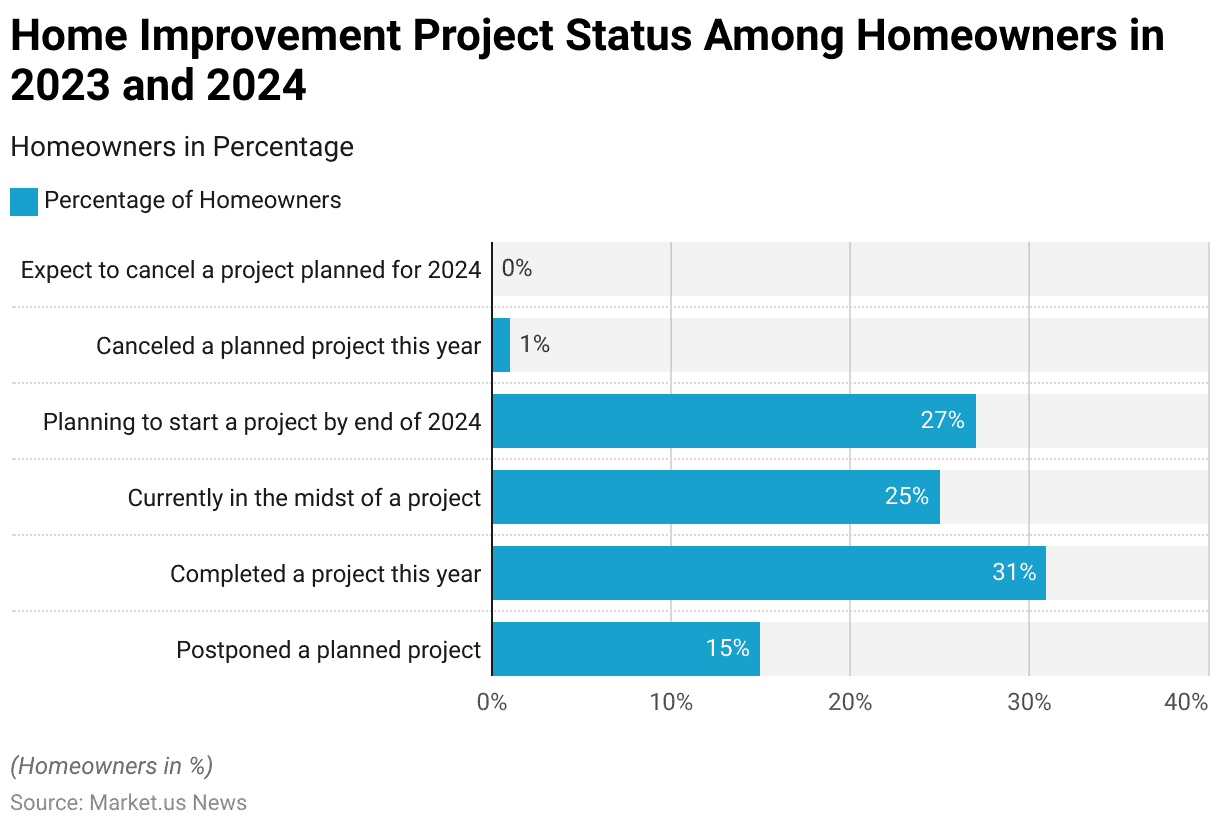
Adoption of Smart Technology in Homes
- The smart home market is experiencing significant growth, with 37% of all internet-connected homes now equipped with at least one smart home device.
- Adoption rates are expected to continue increasing as purchase intentions are at an all-time high.
- Additionally, a report commissioned by HIRI from global market intelligence firm Omdia predicts that the global smart home market will surpass $167 billion by 2025, a substantial rise from approximately $58.5 billion in 2020.
Discuss Your Needs With Our Analyst
Please share your requirements with more details so our analyst can check if they can solve your problem(s)





